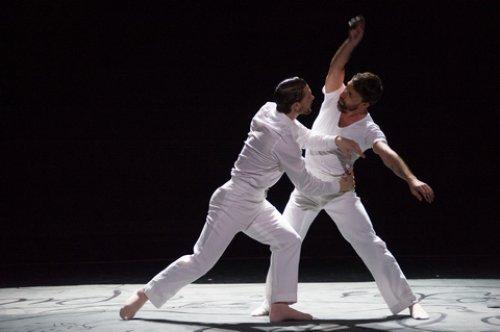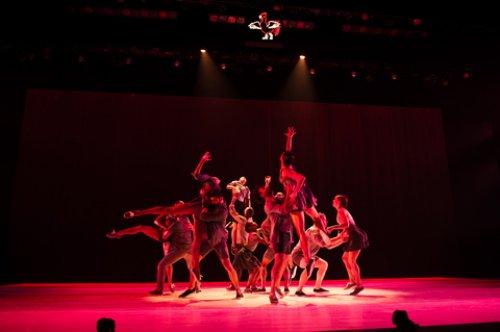Ballet Hispánico: Spring Season 2018
Modern dance dressed up in an exciting and colorful package courtesy of Ballet Hispánico.

Chris Bloom and Omar Román De Jesús in a scene from Ballet Hispánico’s “Espiritus Gemelos” (Photo credit: Paul Lobo)
[avatar user=”Joel Benjamin” size=”96″ align=”left” ] Joel Benjamin, Critic[/avatar] Passion, sex, sensuality, social commentary and—oh, yes—beautiful dancers and colorful choreography filled the Joyce Theater signaling the return of Ballet Hispánico: four fascinating ballets, including two world premieres and two repertory hits.
The dancers displayed a new depth of expression, particularly in the world premiere “Espiritus Gemelos,” a sensitive, beautifully acted duet about a brief same sex encounter performed by Chris Bloom and Omar Román De Jesús. Choreographer Gustavo Ramírez Sansano was inspired by the real-life relationship between the doomed writer, Federico García Lorca and the surrealist painter, Salvador Dalí, two famous Spaniards. He used dim, but colorful music by Manuel de Falla and Jacinto Guerrero to accompany his movements and tell his emotionally rich story.
Clad in Amanda Gladu’s period outfits, the two dancers entered down the theater’s aisle, then through an on stage doorframe meeting in a darkly lit spot (lighting by Bob Franklin) where they tentatively approached each other. The duet was full of slow lifts and shifts away and toward each other until they clearly decided to make a go of it. The choreography was passionate without being overly explicit with De Jesús as Dalí the more reticent of the two.

A scene from Carlos Pons Guerra’s “Waiting for Pepe” as performed by Ballet Hispánico (Photo credit: Paul Lobo)
Ironically—or was it?—the other world premiere, “Waiting for Pepe” by Carlos Pons Guerra had its inspiration in García Lorca whose The House of Bernarda Alba provided the ballet’s central driving theme of sexual frustration. The somber, pensive music was by Banda Ionica, Chavela Vargas, Carlos Campos and Par Ney da Castro and the casual, everyday costumes by Ghabriello Fernando. Franklin’s lighting was moody with sudden changes in palette and intensity.
Pons Guerra structured the work as a series of solos absorbed by a quickly changing chorus which aimed at putting the soloists down for trying to break out. The movements were smooth and even droopy, giving the work a sad ambiance.
The two older works cleverly used old, clichéd forms of dance for witty purposes.
“Linea Recta,” choreographed by Annabelle Lopez Ochoa to a flamenco style guitar score by Eric Vaarzon Morel turned the ancient art of flamenco on its ear. In chic outfits designed by Danielle Truss—red approximations of ruffled dresses and tight red pants—the dancers plugged energetically through Lopez Ochoa’s fierce steps, the women alternating with the men until they joined up for sassy partnering and movements racing through artful lineups and circles.

A scene from Michelle Manzanales’ “Con Brazos Abiertos” as performed by Ballet Hispánico (Photo credit: Paul Lobo)
“Con Brazos Abiertos,” choreographed by Michelle Manzanales to a “soundscape” by Carla Morrison, Cheech & Chong, Julio Iglesias, Edward James Olmos and others plus the eponymously titled poem by María Billini, displayed all the silly hackneyed images of Latino culture as distorted by the American viewpoint: sombreros, folk dancing, explicit sensuality and sexuality, etc., all danced with passion and wit by the troupe wearing Diana Ruettiger’s ethnic-themed costumes. “Con Brazos” was a tongue-in-cheek take on the Ballet Folklórico without that troupe’s pompousness.
Artistic director, Eduardo Vilaro, has taken his troupe to new heights, supporting female choreographers and works of social importance.
Ballet Hispánico (through April 10-15, 2018)
Joyce Theater, 175 Eighth Avenue, in Manhattan
For tickets, call 212-242-0800 or visit http://www.Joyce.org
Running time: two hours including one intermission






Leave a comment